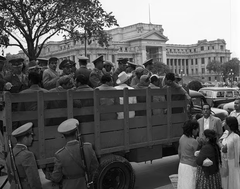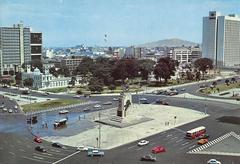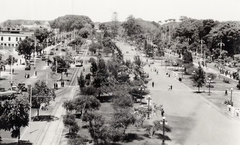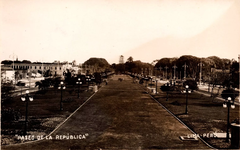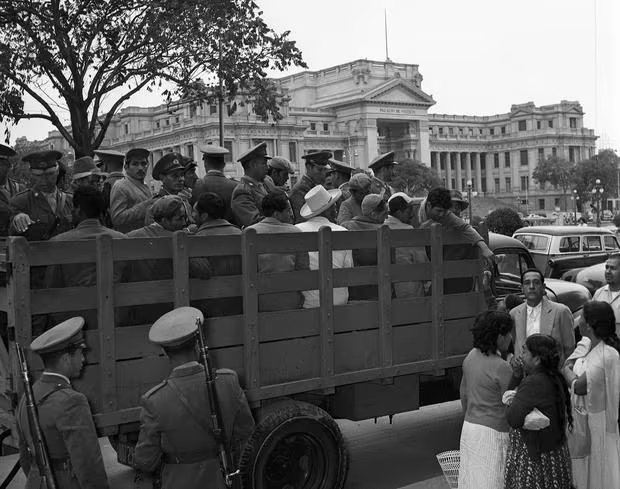
Paseo de los Héroes Navales: Visiting Hours, Tickets, and Historical Sites in Lima
Date: 14/06/2025
Introduction
Located in the heart of Lima, Peru, the Paseo de los Héroes Navales is an iconic esplanade that stands as a tribute to the nation’s naval heroes—most notably those who fought valiantly at the Battle of Angamos during the War of the Pacific. Since its inauguration in 1921 as part of Peru’s centennial independence celebrations, this plaza has become a vibrant civic, cultural, and historical hub. Its strategic position at the start of the Paseo de la República places it amidst significant city landmarks such as the Palacio de Justicia and the Centro Cívico de Lima (Turismo Peruano, Municipalidad de Lima).
The Paseo seamlessly blends neoclassical and modernist architectural elements, featuring an imposing obelisk, busts of naval heroes, and remarkable sculptures. It is a popular venue for national celebrations, cultural performances, and political gatherings, attracting both locals and tourists with its accessibility, free admission, and integration into Lima’s public transportation network (Urbipedia, Metro de Lima). Visitors can immerse themselves in Peruvian history, enjoy leisurely walks in landscaped gardens, and easily visit nearby institutions like the Museo de Arte Italiano and Parque de la Exposición.
This comprehensive guide presents the essential details for planning your visit, including historical context, architectural highlights, practical visitor tips, and recommendations for making the most of your experience at one of Lima’s most treasured sites (Peru Info, El Comercio).
Table of Contents
- Historical Context and Origins
- Architectural Features and Sculptural Heritage
- Urban Development and Modernization
- Visiting Hours, Tickets, and Accessibility
- Events, Civic Life, and Cultural Activities
- Nearby Attractions and Travel Tips
- Conservation and Heritage Status
- Safety, Amenities, and Visitor Advice
- Frequently Asked Questions (FAQ)
- Conclusion and Call to Action
- References and Further Reading
Historical Context and Origins
Paseo de los Héroes Navales was conceived as a monumental urban space to honor the memory of Peru’s naval heroes, particularly those of the War of the Pacific and the decisive Battle of Angamos on October 8, 1879. Construction began under President Augusto B. Leguía, and the plaza was officially inaugurated on October 8, 1921, as part of the country’s centennial independence festivities (Turismo Peruano). Its location at the start of Paseo de la República—a main urban artery—reflected a vision to integrate national memory into the city’s everyday life and to modernize the capital’s civic infrastructure (Urbipedia).
The name “Paseo de los Héroes Navales” directly references the naval officers who are central to Peru’s national identity, such as Admiral Miguel Grau, whose leadership and sacrifice at Angamos have come to symbolize patriotism and honor (Peru Info).
Architectural Features and Sculptural Heritage
The plaza’s layout features a harmonious blend of neoclassical and modernist styles, with a central obelisk and a series of busts and statues commemorating key naval figures. Among the most prominent are busts of Carlos de los Heros, Elías Aguirre, Diego Ferre, Pedro Garezon, Gervasio Santillana, Fermín Diez Canseco, José Rodríguez, and Enrique Palacios (Turismo Peruano).
Six notable sculptures, declared part of Peru’s national heritage, adorn the plaza. The bronze works ‘La yunta’ and ‘Las llamas’—gifts from Lima’s Chinese community in 1938—highlight Peru’s multicultural ties and the value of labor (El Comercio). Four iron pieces—a pair of phoenixes, a lion, and a tiger—crafted by French artists Charles Valton and Henri Jacquemart, were relocated to the promenade in 1945.
The central monument to Admiral Miguel Grau—one of Peru’s most revered national heroes—stands atop a granite pedestal and is flanked by bas-reliefs illustrating pivotal naval engagements (El Comercio).
Urban Development and Modernization
Surrounded by major civic and cultural institutions—including the Palacio de Justicia, Edificio Rímac, Centro Cívico de Lima, Hotel Sheraton, and Museo de Arte Italiano—the plaza has always been a focal point of Lima’s urban life (Urbipedia).
A significant milestone was the construction of the Estación Central Subterránea in 2007, part of the Metropolitano rapid transit system, which now lies beneath the plaza and serves over 110,000 passengers daily (Urbipedia). This project included the creation of a subterranean commercial center and improved pedestrian connectivity, while restoration work preserved the site’s historical integrity.
Recent urban revitalization efforts have enhanced the plaza’s landscaping, lighting, and security, making it both a historical landmark and a modern urban corridor (Municipalidad de Lima).
Visiting Hours, Tickets, and Accessibility
- Hours: Open daily from 6:00 AM to 10:00 PM.
- Admission: Free entry for all visitors; no tickets required.
- Accessibility: The plaza is wheelchair- and stroller-friendly, with smooth, wide pathways and ramps.
- Public Transportation: The Metropolitano’s Estación Central Subterránea provides direct access, connecting the site with various Lima districts (Metro de Lima).
Additional amenities include benches, shaded seating, public restrooms, and nearby cafés and shops. Guided tours—available in Spanish and English—can be booked through local operators or visitor centers.
Events, Civic Life, and Cultural Activities
The Paseo de los Héroes Navales is a central stage for Lima’s social and civic life. It hosts:
- National celebrations such as Navy Day (October 8th), with military parades, ceremonies, and cultural events (El Comercio).
- Political rallies, demonstrations, and civic gatherings, including historic events like the “Marcha de los Cuatro Suyos.”
- Cultural activities: Open-air concerts, art exhibitions, artisan fairs, and food festivals such as “Feria del Emprendedor” and “FestiAsia.”
- Sporting and recreational events: Automobile exhibitions, races, and spaces for jogging or leisurely walks.
The plaza’s lively atmosphere is especially notable on weekends and public holidays.
Nearby Attractions and Travel Tips
Enhance your visit by exploring nearby landmarks:
- Palacio de Justicia: Peru’s Supreme Court and an architectural marvel.
- Museo de Arte Italiano and Museo de Arte de Lima (MALI): Key cultural institutions (Museo de Arte de Lima).
- Parque de la Exposición: Historic park with museums and event spaces.
- Edificio Rímac and Plaza Grau: Notable for historic architecture.
Travel Tips:
- Early mornings and late afternoons offer the best lighting for photography and comfortable weather.
- Wear comfortable shoes and bring water, especially in warmer months.
- Avoid isolated areas after dark and be mindful of personal belongings during crowded events.
Conservation and Heritage Status
Declared a Republican Cultural Heritage Site in 2001, the plaza’s preservation is a priority for both local authorities and the community (Turismo Peruano). Restoration projects led by Prolima and the Municipality of Lima involve technical conservation of sculptures and regular maintenance of landscaping and amenities (El Comercio). During public demonstrations, protective measures are enforced to safeguard artworks.
Safety, Amenities, and Visitor Advice
- Safety: The area is well-patrolled during the day and at major events, with surveillance cameras installed. Exercise caution with valuables and avoid isolated sections after dark.
- Amenities: Benches, shaded areas, public restrooms, and nearby cafés are available. Accessibility features include ramps and wide walkways.
- Transportation: The Metropolitano and taxis are the most convenient means of access; parking is limited.
Frequently Asked Questions (FAQ)
Q: What are the visiting hours for Paseo de los Héroes Navales?
A: Open daily from 6:00 AM to 10:00 PM.
Q: Is there an entrance fee or ticket required?
A: No, entry is free for all visitors.
Q: Are guided tours available?
A: Yes, guided tours can be arranged through local operators.
Q: How do I get there?
A: The Metropolitano’s Estación Central provides direct access.
Q: Is the plaza wheelchair accessible?
A: Yes, with ramps and smooth pathways.
Q: Are there regular events or festivals?
A: Yes, including Navy Day, artisan fairs, and cultural performances.
Conclusion and Call to Action
Paseo de los Héroes Navales is a living monument to Peru’s naval legacy, civic spirit, and vibrant urban culture. With its unique blend of history, art, and public life, the plaza offers an enriching experience for all visitors. Plan your visit to coincide with special events, enjoy a guided tour, or simply relax amidst the gardens and monuments.
For up-to-date information, event listings, and interactive maps, visit the official website of the Municipalidad de Lima. Enhance your experience with guided tours and digital resources—consider downloading the Audiala app for curated tours and real-time updates on Lima’s historical sites.
References and Further Reading
- Turismo Peruano - Paseo de los Héroes Navales in Lima: Visiting Hours, Tickets, and Historical Significance of This Iconic Lima Historical Site
- Municipalidad de Lima - Paseo De Los Héroes Navales: Visiting Hours, Tickets & Exploring Lima’s Historic Naval Landmark
- Municipalidad de Lima - Visiting Paseo De Los Héroes Navales in Lima: Hours, Tickets, and Historical Highlights
- El Comercio - Paseo de los Héroes Navales: Visiting Hours, Events, and Lima Historical Sites Guide
- Urbipedia - Paseo de los Héroes Navales
- Peru Info - Paseo De Los Héroes Navales
- Metro de Lima - Estación Central
- Museo de Arte de Lima (MALI)
